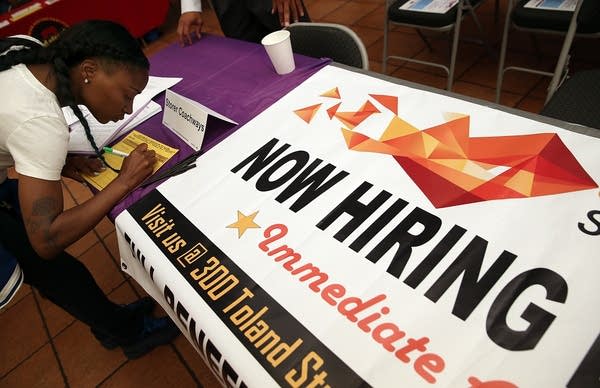US unemployment aid applications fall to 304,000

Go Deeper.
Create an account or log in to save stories.
Like this?
Thanks for liking this story! We have added it to a list of your favorite stories.
Fewer people sought U.S. unemployment benefits last week, driving down the level of applications to nearly the lowest in seven years.
Weekly applications for unemployment aid dropped 11,000 to a seasonally adjusted 304,000, the Labor Department said Thursday. That's not far from a reading of 298,000 two months ago, which was the lowest since 2007, before the Great Recession began.
The four-week average, a less volatile measure, dipped 3,500 to 311,500, the second-lowest level since August 2007. Applications are a proxy for layoffs, so the low readings indicate that employers are letting go of fewer workers.
The figures are the latest sign that the job market is steadily improving. Employers are adding jobs at a healthy clip and the unemployment rate is at a 5 1/2-year low.
Turn Up Your Support
MPR News helps you turn down the noise and build shared understanding. Turn up your support for this public resource and keep trusted journalism accessible to all.
"The ... data remain extremely encouraging," said Jim O'Sullivan, chief U.S. economist at High Frequency Economics. The four-week average is down from last year's average of 343,000, he noted.
Still, some economists warned that the figures could be volatile in the weeks ahead. That's because auto manufacturers typically close their plants in July to prepare for new models to be released in the fall. That can cause spikes in temporary layoffs.
The number of people receiving benefits ticked up 10,000 to 2.58 million. That's down from about 4.5 million a year ago. Much of that decline has occurred because an extended benefits program expired at the end of last year.
A separate government report Tuesday showed that total layoffs in May fell below 1.6 million, lower than even pre-recession levels. And more workers are quitting their jobs, the report found, which can be a sign of confidence, since most workers quit when they have new positions or are confident they can find one.
In addition, the number of open jobs jumped to the highest level in seven years, a sign that companies could step up hiring in the months ahead.
Employers, meanwhile, added 288,000 jobs in June, the fifth straight month of job gains above 200,000. That's the first such stretch since 1999. The unemployment rate fell to 6.1 percent, the lowest since September 2008.
However, the steady hiring gains have yet to spur big increases in wages, which have barely kept pace with inflation since the end of the recession five years ago.
But more people with jobs means more paychecks, which could boost consumer spending and growth. After a sharp contraction in the economy in the first three months of the year, most economists expect growth to return in the April-June quarter and top 3 percent at an annual pace in the second half of 2014.


